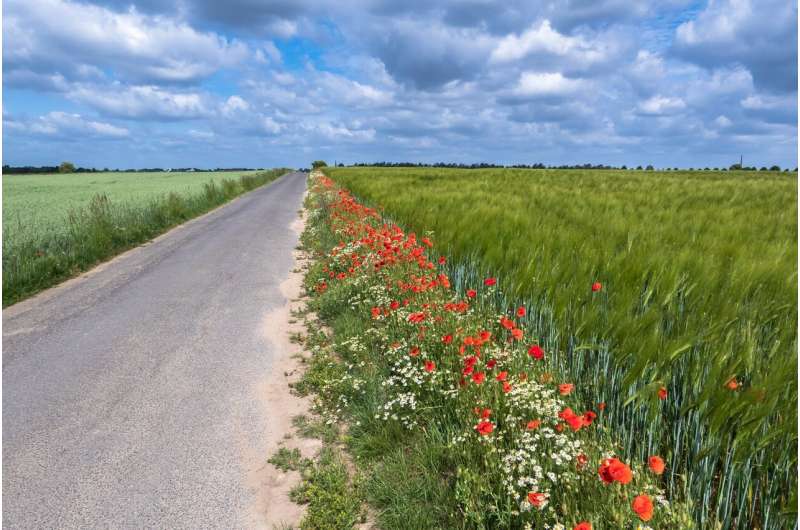Road verges provide opportunity for wildflowers, bees and trees

Road verges cover 1.2% of land in Great Britain—an area the size of Dorset—and could be managed to help wildlife, new research shows.
University of Exeter researchers used Google Earth and Google Street View to estimate that verges account for 2,579 km2 (almost 1,000 square miles) of land.
About 27% of these verges are frequently mown, 41% is wilder grassland, 19% is woodland and the rest is scrub.
There are "significant opportunities" to improve verges by reducing mowing and planting trees, the researchers say.
"Our key message is that there's a lot of road verge in Great Britain and we could manage it much better for nature," said lead author Ben Phillips, of the Environment and Sustainability Institute on Exeter's Penryn Campus in Cornwall.
"About a quarter of our road verges are mown very regularly to make them look like garden lawns—this is bad for wildlife."
Previous research has shown that reducing mowing to just once or twice per year provides more flowers for pollinators, allows plants to set seed and creates better habitats for other animals.
Phillips said: "Some parts of verges need to be mown regularly for safety, but many verges could be mown much less, and this could save money due to reduced maintenance costs.
"We found that only a quarter of frequently mown verges had trees, so there's potential to add trees and shrubs, which will also help to capture carbon.
"But tree planting must be done carefully to avoid damaging flower-rich grass verges, and to prevent any impacts on visibility for drivers, or damage to infrastructure from roots and branches."
Planting trees in some verges could provide a wide range of benefits for people, nature and the environment, and contribute towards the UK government's tree-planting ambitions.
As well as estimating land area of verges, the study found that 1.8% of Great Britain is covered by hard road surfaces.
The charity Plantlife is currently running a campaign called #NoMowMay, asking gardeners and councils to "lock up your lawnmower" for the month of May.
The study, carried out in collaboration with the UK Centre for Ecology and Hydrology, was funded by the Natural Environment Research Council and the Cornwall Area of Outstanding Natural Beauty unit.
The new study, published in the journal Landscape and Urban Planning, is titled "Road verge extent and habitat composition across Great Britain."
More information: Benjamin B. Phillips et al, Road verge extent and habitat composition across Great Britain, Landscape and Urban Planning (2021). DOI: 10.1016/j.landurbplan.2021.104159
Provided by University of Exeter



















